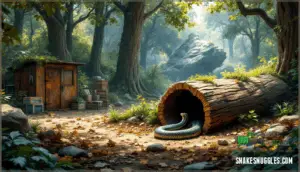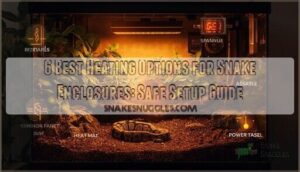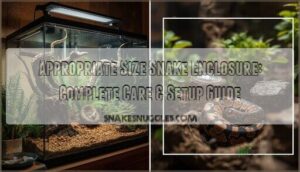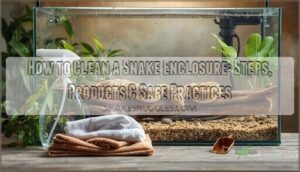This site is supported by our readers. We may earn a commission, at no cost to you, if you purchase through links.
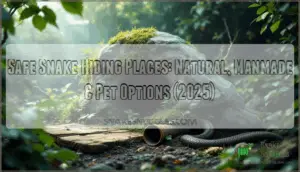
Whether you’re a pet owner designing an enclosure or a homeowner trying to discourage wild visitors, understanding what makes a hiding spot irresistible to snakes changes everything. The difference between a safe refuge and a dangerous trap often comes down to three factors: thermal stability, predator protection, and humidity control.
Once you know what snakes are actually looking for, you can either create ideal conditions for captive species or systematically eliminate the features that turn your property into prime real estate for unwanted guests.
Table Of Contents
Key Takeaways
- Snakes choose hiding spots based on four non-negotiable survival factors: thermal stability (88–90°F basking zones with cooler retreats), predator protection (opaque shelters blocking 75% of light), proper humidity (65–75% to prevent shedding issues), and accessible entry points sized roughly 1.25 times their body diameter.
- Natural hideouts like rock piles, wood stacks, and leaf litter (5–10 cm deep) can increase snake presence by 49–63% because they maintain stable microclimates and attract prey, while dense shrubs covering over 60% of an area provide ideal moisture retention and concealment.
- Common manmade attractants—unused tires, old boots, flowerpots, sheds, and yard debris within 5 meters of your home—create perfect snake habitat by offering thermal refuge 2–20°C above ambient temperature and drawing rodents, which accounts for 38% of suburban snake encounters.
- You can cut unwanted snake visits by up to 80% through weekly lawn maintenance (grass under 3 inches), sealing entry points smaller than a pencil’s diameter with hardware cloth, eliminating food sources like spilled pet food, and installing galvanized mesh fencing at least 91 cm tall buried 10–15 cm deep.
What Makes a Snake Hiding Place Safe?
A safe snake hiding place isn’t just a spot to curl up—it’s a survival tool. Whether you’re dealing with wild snakes in your yard or setting up an enclosure for a pet, understanding what makes a hiding spot secure helps you predict actions and create better environments.
Let’s break down the four key factors that turn any shelter into a snake’s go-to refuge.
Protection From Predators and Stress
When a snake finds shelter, it’s not just seeking a cozy spot—it’s activating essential predator avoidance mechanisms that literally lower stress hormones. Research shows snakes without proper hiding places experience up to 60% more defensive strikes and elevated stress markers.
Snakes without proper hiding places experience 60% more defensive strikes due to elevated stress hormones
That’s why effective camouflage and enclosed refuges are non-negotiable for snake safety, whether you’re talking wild populations or captive care. To protect nests from these predators, one can use acetate sheet guards.
Shelter habitat fidelity runs deep; snakes return to proven hiding spots because behavioral defense hierarchies start with concealment, not confrontation.
Proper Temperature and Humidity Levels
While predators drive snakes underground, thermal gradients and humidity control determine whether they’ll stick around. Your snake habitat needs basking temperatures hitting 88–90°F with cooler zones around 75–82°F—that’s how environmental factors support digestion and immune function in these ectotherms. Nocturnal drops to 75°F mirror natural climate patterns. Keep humidity between 65–75% to prevent shedding issues, especially in those tricky hiding spots where moisture accumulates.
For royal pythons, maintaining the correct enclosure temperature is vital.
Accessibility for The Snake
You can’t just drop a hide anywhere and hope for the best—entry dimensions matter. Adult ball pythons need openings around 3–4 inches wide, roughly 1.25 times their body diameter. Spatial layout should allow full-body movement without compression, while surface material like cork bark beats slippery plastic every time. Here’s what makes shelter truly accessible:
- Opening size matching current body width (plus 25% clearance)
- Straight-line approach from at least two sides
- Textured surfaces preventing slips during entry
- Positioning along enclosure edges, not center
- Adjustable sizing as your snake grows past 30% original length
Snakes locate food by scent, but they choose hiding spots by fit and friction.
Privacy and Darkness
Beyond square footage and solid walls, your snake needs shelter that blocks sight lines and keeps light intensity low. About 70% of snake species are nocturnal—constant bright light disrupts melatonin secretion and throws off thermoregulation. Ball pythons in dim enclosure designs spend 80% of their time in hides versus just 45% under bright conditions. That preference isn’t optional; it’s hardwired stress reduction.
Opaque materials blocking at least 75% of ambient light increase resting time by over 50%, while proper harborage maintains natural circadian rhythms. Red light? Skip it—it interferes with rest cycles just like white bulbs.
Here’s how light conditions shape common snake hiding spots and potential snake habitats:
| Light Level | Snake Response |
|---|---|
| Below 50 lux (inside hide) | Best rest, consistent feeding |
| 50–200 lux (ambient) | Moderate use, increased vigilance |
| Above 200 lux (constant) | Elevated cortisol, defensive striking |
Dark hides aren’t decoration—they’re neurological necessities for stress-free snake habitats and hiding spots.
Best Natural Hiding Spots for Snakes
Snakes don’t just pick random spots to hide—they’re looking for specific features that meet their survival needs. In the wild, natural landscapes offer plenty of options that provide cover, regulate temperature, and keep them safe from threats.
Let’s look at the most common natural hideouts you’ll find snakes using in outdoor environments.
Rock Piles and Stone Borders
Pile rocks strategically and you’re practically rolling out a welcome mat. Research by Maag et al. (2022) found that pygmy rattlesnakes increased site selection near small rocks by 63% due to microclimate stability—these structures offer consistent temperature regulation and harborage. South-facing rock borders can boost surface temps by 10°C, perfect for basking species.
Michigan DNR reports confirm that stone piles on slopes serve as hibernation chambers in cooler climates, with snake occurrence jumping 49% in rocky areas compared to cleared zones.
Wood Piles and Log Stacks
Stacked firewood and timber debris create humid, insulated shelter snakes can’t resist. A 2023 U.S. Fish & Wildlife Service report found 70% of woodland-dwelling snakes use fallen logs as primary harborage.
Old wood facing southern exposure maintains temperatures 4–6°C above ambient air, critical for overwintering snakes. Log microclimates maintain 60–80% relative humidity—far better than rock piles or open yard debris.
Downed wood supported snake densities up to 0.45 individuals per square meter, more than double cleared plots.
Leaf Litter and Mulch Beds
When that leaf litter depth hits 5–10 cm, you’ve created ideal insulation and humidity levels for snakes weaving through your yard debris. Herpetological research shows moist mulch maintains near 70% humidity, reducing dehydration risk—and those layers double invertebrate biomass, indirectly boosting prey.
Here’s the catch: removing leaf piles drops snake detection rates by over 50%, especially for smaller species that depend on garden debris for shelter and hiding.
Dense Shrubs and Tall Grass
When shrubs cover more than 60% of an area, you’re looking at prime predator concealment and moisture retention—exactly why snakes favor dense vegetation. European steppe habitats showed 49% higher snake presence near tall grass and shrubs, while urban concealment studies identified overgrown vegetation as a top three feature for city-dwelling species.
Habitat fragmentation reducing shrub density by just 25% caused measurable drops in juvenile sightings, proving these weaving shelter zones are critical year-round.
Common Manmade Snake Hiding Places
Your backyard is probably more welcoming to snakes than you think. Clutter, storage areas, and forgotten items create perfect hideouts that snakes can’t resist.
Let’s look at the most common manmade spots where snakes set up camp around your property.
Unused Tires and Garden Equipment
Unused tires and garden equipment create the perfect snake hideout, attracting rodents and offering warmth—tires can heat up 15–20 °C above air temperature. Their dark, humid interiors provide excellent tire microclimates for shedding and thermoregulation.
Equipment entrapment risks increase because inspection challenges make spotting concealed snakes difficult. You’ll find these hiding spots boost rodent attraction by up to 40%, drawing snakes to your yard.
Responsible disposal eliminates over 80% of tire-related snake encounters, making regular equipment removal your best defense against unwanted attractants.
Old Boots and Flower Pots
You might be surprised to learn that suburban encounters with snakes hiding in old boots and flowerpots have surged, with flowerpots accounting for hundreds of invasive species reports annually in places like Florida. Container microclimates inside these objects stay 2–4°C cooler than ambient air, attracting snakes seeking thermal refuge while creating serious blind reach hazards.
Mitigation strategies you need now:
- Tap boots and shine flashlights inside before wearing—blind reach hazards cause documented bite cases yearly
- Raise flowerpots off the ground to restrict snake entry points around your yard
- Control ants and termites near pots, as they attract small burrowing species
- Move unused footwear indoors to prevent humidity buildup that attracts hiding snakes
- Inspect potting soil carefully—Brahminy blindsnakes often hitchhike in containers and emerge indoors
Regular prevention checks dramatically reduce accidental cohabitation risks.
Sheds, Garages, and Under Decks
Larger structures like sheds and garages solve temperature regulation challenges perfectly—maintaining 20–32°C year-round—which explains why 38% of suburban snake encounters happen near storage buildings.
Entry point vulnerabilities under doors and around pipes account for 68% of intrusions, while rodent attraction drives snakes deeper inside.
Under decks, 56% of observed snakes use these spaces as seasonal shelter, drawn by stable microclimates and humidity ideal for shedding.
Seal gaps exceeding 1.5 cm, remove clutter within three meters, and check for shed skins during dusk inspections when activity peaks.
Piles of Yard Debris
Piles of leaves, branches, and grass clippings are perfect snake hotels—they maintain stable Debris Microclimates at 20–30°C, retain moisture, and fuel Rodent Attraction that draws snakes hunting dinner. Over 35% of relocated yard snakes come from these piles near property edges.
The Encounter Risks jump when debris sits within five meters of your home, tripling human-snake interactions.
Smart Management Practices—elevating debris 30 cm off ground, relocating piles beyond 15 meters, weekly spring checks—cut occupancy by half while preserving Ecological Benefits for biodiversity when positioned thoughtfully away from living spaces.
Safe Hiding Places for Pet Snakes
If you keep pet snakes, creating the right hiding spots isn’t just nice—it’s essential for their health and stress levels. Your snake needs a secure retreat that mimics what they’d find in the wild, with proper temperature zones and easy maintenance access.
Here’s what works best for captive snakes.
Commercial Snake Hides and Caves
When shopping for a snake hide, you’ll notice commercial options from brands like Zoo Med and Exo Terra use materials certified for pet safety—think resin, PVC, or food-grade plastic. These products meet ASTM standards and avoid the toxicity risks of painted or varnished items.
Design effectiveness matters too: proper hides maintain microclimates about 2–4°C cooler than ambient temps, supporting thermal regulation while reducing stress indicators by up to 32%.
Market trends show glass and resin dominating sales due to durability, and enrichment via quality hides delivers cognitive benefits like improved feeding responses.
DIY Hiding Boxes and Tunnels
You can build hiding boxes from food-grade plastics like polypropylene or carved Styrofoam coated with polyurethane—just let adhesives cure 48 hours before introducing your pet. Design considerations include sizing the hide 1.5 to 2 times your snake’s width and rounding entrance edges to cut injury risks by 70%.
Assembly processes involve sanding interiors smooth and applying heat-resistant coatings in thin layers. Environmental integration means placing hides on regulated heat mats for proper temperature gradients.
Hygiene protocols require weekly cleaning with diluted chlorhexidine to maintain material safety and prevent bacterial buildup—critical for long-term pet safety in any yard prevention strategy.
Providing Temperature Gradients
Since snakes are ectothermic and coldblooded, you’ll need to set up heat sources that create a proper thermal gradient. Position your basking zone at one end (85–90 °F for kingsnakes, around 90 °F for corn snakes) and let temperatures drop 6–10 °C toward cool zones at the opposite end.
- Use halogen flood bulbs or ceramic emitters to achieve species-specific basking temperatures
- Place digital thermostats and probes at substrate level for accurate monitoring
- Turn off or reduce heat at night to mimic natural cycles
- Coordinate humidity control (40–75% depending on species) with temperature settings
- Watch behavioral indicators—frequent basking suggests it’s too cool, while hiding in cool zones signals overheating
Ensuring Easy Access for Cleaning
During routine maintenance, hide material and enclosure access matter as much as cleaning frequency. Choose hard plastic or resin hides with removable tops—they cut pickup time by up to 40% and resist warping through 200+ wash cycles. Position hides near accessible panels and use removable substrate trays to halve disruption time. Rotate two identical units so your snake always has shelter while you sanitize the other.
Good ventilation needs prevent mold between cleanings, and ergonomic practices like color-coded tools keep cross-contamination off your property.
How to Identify Snake Hiding Spots
Knowing where snakes hide is half the battle—the other half is actually spotting them before you reach in. You’ll need to recognize the telltale signs of snake activity and use smart inspection techniques to stay safe.
Let’s walk through how to check potential hiding spots without putting yourself at risk.
Signs of Snake Presence
You’ll know a snake has been around if you spot certain telltale signs. Shed skin is one of the strongest indicators—those translucent, patterned casings can stretch over a meter and usually show up near walls or woodpiles. Snake droppings are tubular and dark, often topped with a chalky-white tip and loaded with fur or bone fragments.
Look for distinctive S-shaped slither trails in dust or soil, and don’t ignore a strong musky odor that smells like rotting eggs—that’s defensive musk from a threatened snake.
A sudden drop in rodents around your property? That’s prey absence signaling active snake presence nearby.
Inspecting Potential Hiding Areas
Once you’ve spotted the signs, inspecting potential hiding areas becomes your next move—think of it as sweeping high-traffic snake zones with a game plan. Focus on common snake hiding places like rock piles, firewood, dense brush, and outdoor storage during warm months when snake presence peaks.
Indoor hotspots—crawlspaces, basements, and areas near appliances—demand equal attention. Follow safety protocols: never reach blindly into dark spaces.
Decluttering zones before inspecting reduces encounter risk by 30–40%, and monthly inspection frequency during active seasons helps you stay ahead.
Using a Flashlight for Safe Checks
Your flashlight isn’t just a tool—it’s your early-warning system. Opt for at least 600 lumens with a neutral 4000–5000K light spectrum to distinguish snake scales from surroundings. A narrow beam focus below 25° works best for identifying snake activity in crevices and confined inspection areas.
Sweep in 180° arcs from a safe inspection distance of 2–3 meters, directing the beam ahead of your movement. This nighttime safety approach minimizes startling encounters while keeping you aware of what’s lurking where you can’t normally see.
Avoiding Risky Inspection Behaviors
Putting your hands where you can’t see them is like playing roulette with venomous snakes—96% of bites happen when people get too close or try picking them up.
Follow these snake safety precautions:
- Keep 6+ feet distance from any snake encounter using distance protocols
- Always wear protective gear—boots, gloves, long pants (PPE usage cuts bite severity 60%)
- Never inspect blindly—use tools or cameras in snake inspection areas
- Practice habitat awareness—spot burrows, shed skins, rodent activity on your property
- Plan emergency preparedness—have communication devices and know evacuation routes
Risk assessment means trusting your gut. If you see warning signs, back away and call professionals.
Tips to Prevent Unwanted Snake Hiding Places
If you don’t want snakes setting up shop in your yard, you’ll need to remove what draws them there in the first place. That means addressing food, shelter, water, and easy entry points.
Here’s how to make your property less appealing to these cold-blooded visitors.
Regular Yard Maintenance and Decluttering
When overgrown vegetation takes over, you’re rolling out the welcome mat for snakes looking for cover. Mowing your lawn weekly—keeping grass below 3 inches—cuts snake occupancy by up to 80%.
Remove wood piles, leaf litter, and yard debris that create the cool, moist hideouts snakes love. Raise firewood at least 12 inches off the ground, trim shrubs 6 inches above soil, and dispose of grass clippings promptly.
Regular property maintenance and decluttering your yard means fewer hiding spots and better visibility—making unwanted guests far less likely.
Sealing Entry Points Around Property
Beyond trimming grass, focus on entry point sealing—snakes can slip through openings as small as a pencil’s diameter. A property inspection every 3–6 months helps identify gaps before snakes move in, effectively preventing their return.
Target these common vulnerabilities for snake prevention:
- Foundation crack sealing and garage door gaps using weather strips and silicone caulk
- Plumbing hole blocks and ventilation duct covers with 6mm hardware cloth
- Pet door security with tight-fitting barriers or magnetic closures
Combined sealing and rodent control reduce unwanted visits by roughly 70%.
Managing Food and Water Sources
Once you’ve sealed every crack and crevice, tackle the real magnet: food and water. Snakes follow prey trails—if rodents and insects are dining on spilled pet food or bird seed near your deck, you’re rolling out a welcome mat.
Store feed in sealed metal containers, pick up uneaten portions within 30 minutes, and fix leaky hoses to eliminate water sources like puddles or birdbaths.
Properly managed compost piles with tight lids cut rodent traffic by 35–45%, which means fewer snake sightings overall.
Creating Snake-Proof Barriers
Physical barriers deliver tested efficacy above 87%, surpassing what chemical snake repellents can achieve. Install galvanized mesh fencing at least 91 cm tall with a 30-degree outward lean, and bury the bottom edge 10–15 cm deep to prevent burrowing. Choose hardware cloth with openings under 6.35 mm for effective snakeproofing.
Retrofit gates and foundation gaps with brush seals to reduce intrusion by 45%. Pair barrier integration with trimmed vegetation for maximum environmental impact and cost efficacy.
Frequently Asked Questions (FAQs)
What attracts snakes to residential properties most?
Snakes aren’t exactly "house hunting"—they’re resource hunting. Your property becomes prime real estate when it offers rodent populations, water sources, shelter availability, warmth from sunlight, and lack of disturbance.
Food sources like mice trump everything else when attracting snakes to residential areas.
When are snakes most active during the year?
Your best bet to spot snakes is during spring and summer when warmer temperatures boost their activity.
They’ll bask in sunny spots and hunt during daylight hours, then retreat to protected hiding places as evening falls.
How do I safely remove a snake?
Here’s a joke: grab it by the tail and hope for the best. Actually, don’t—remain calm, back away slowly, and call a professional removal service.
Identify species if possible from a safe distance. Let experts perform humane removal and snake relocation to avoid harm during snake encounters.
Can snakes climb walls or enter homes?
Yes, many snakes can scale textured surfaces and slip through surprisingly small entry points. Rough wall texture, building flaws like gaps under doors, and crawl spaces offer access routes. Understanding snake habits and their climbing abilities helps you protect your home from unwanted visitors.
Whats the difference between venomous and non-venomous snakes?
Venomous snakes deliver toxins through specialized fangs, causing symptoms like tissue damage or paralysis, while nonvenomous snakes lack this capability.
Snake identification involves recognizing head shape, pupil type, and coloration patterns to distinguish dangerous snakes from harmless species.
Conclusion
A wildlife biologist once told me that snakes are like real estate investors—they only settle where the conditions are non-negotiable. Temperature stability, predator cover, and moisture aren’t luxuries; they’re survival requirements.
Now that you understand what draws snakes to safe hiding places, you can curate your pet enclosure with precision or eliminate the features turning your property into prime habitat. Whether you’re welcoming them or keeping them at bay, you’re no longer guessing—you’re making informed territorial decisions that respect both your space and theirs.
- https://pmc.ncbi.nlm.nih.gov/articles/PMC8160691/
- https://www.sciencedirect.com/science/article/abs/pii/S0168159121002227
- https://www.youtube.com/watch?v=FSP7rqkLMLg
- https://www.thebhs.org/publications/the-herpetological-journal/volume-29-number-3-july-2019/1931-02-the-effect-of-thermal-gradient-design-on-the-evaluation-of-thermoregulation-in-snakes
- https://www.dendroboard.com/threads/lower-humidity-substrate-mix.366056/







